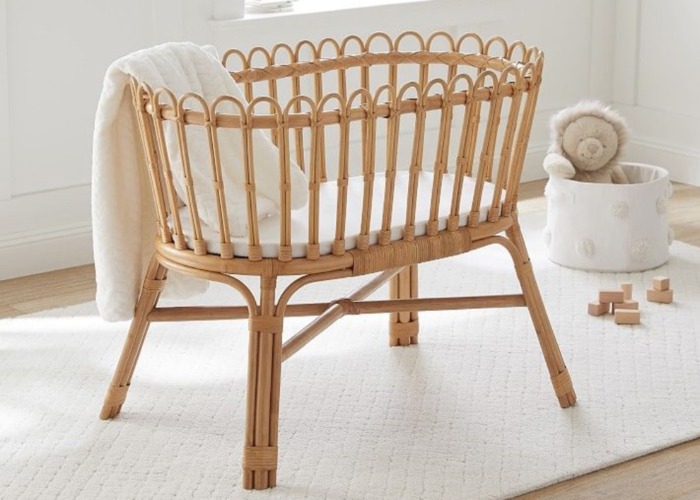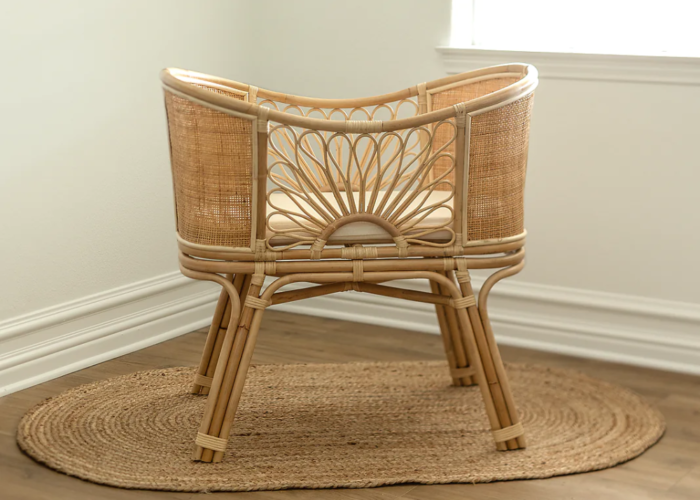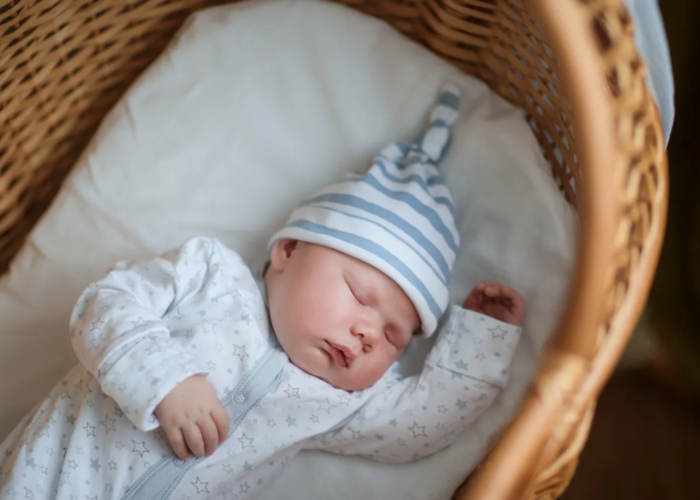When you are pregnant, there are many things to prepare for your soon-to-arrive baby. You need to buy clothes, diapers, toys, and many other items. However, one thing you might not think about is the bassinet. A bassinet is where the baby will sleep in the first few months of life. Did you know that there are various types of bassinets, and not all of them are safe for babies?
In this article, we will answer the question, “are wicker bassinets safe” and provide you with advice on choosing the most suitable bassinet for your baby.
Contents [hide]
1. Are wicker bassinets safe?
Rattan wicker bassinets are safe for babies for several reasons. Firstly, rattan wicker is typically woven tightly, reducing the risk of entrapment or injury. Additionally, rattan wicker allows for good airflow, which helps prevent overheating and ensures proper ventilation for the baby.
As long as the bassinet is well-constructed and meets safety standards, with a firm mattress and adherence to weight limits, it can provide a secure and comfortable sleeping environment for infants.
Regular inspections for any signs of wear or damage are also important to maintain safety.

One issue with wicker bassinets is that they can be prone to mold if not properly cleaned and stored. Mold can lead to allergic reactions, nasal congestion, coughing, and breathing difficulties for the baby. To prevent mold, it is advisable to regularly wipe and air out wicker bassinets, especially in humid weather conditions.
Another concern with wicker bassinets is the potential for breakage or cracking due to impacts or prolonged use. This could pose a risk of injury to the baby if sharp or protruding fibers result from breakage. It is essential to thoroughly inspect wicker bassinets before placing the baby inside and replace them if there are signs of damage.
Wicker bassinets can be an excellent choice for parents looking to create a beautiful and comfortable sleeping space for their baby. However, it’s crucial to be mindful of safety issues when using wicker bassinets and to adhere to the manufacturer’s warranty and maintenance guidelines.
2. Tips to choose a wicker bassinet for your baby
A wicker bassinet can be an excellent choice for your beloved baby, providing not only warmth and comfort but also adding an elegant and luxurious touch to the nursery. However, to select a suitable wicker bassinet, consider the following tips:
- Material: Opt for wicker bassinets made from natural materials, without chemical treatment, to ensure the baby’s safety and health. Thoroughly inspect for any cracks, breakages, or sharp wicker fibers that could pose a danger to the baby.
- Size: Choose wicker bassinets of appropriate size—neither too large nor too small—allowing the baby to comfortably rest and move. Pay attention to the height of the bassinet, facilitating easy placement and retrieval of the baby.

- Mattress and Bedding: Select soft, breathable, and absorbent mattresses and bedding. Choose gentle, harmonious colors that match the bedroom’s style. Regularly clean and replace the mattress and bedding to prevent bacteria and dust buildup.
- Accessories: Enhance your baby’s wicker bassinet with accessories like hanging toy hooks, cozy blankets, soft pillows, or curtains. These additions not only make the bassinet more lively and charming but also stimulate the sensory and cognitive development of the baby.
By following these tips, you can ensure that your chosen wicker bassinet meets both aesthetic and functional requirements while providing a safe and comfortable haven for your precious little one.
3. FAQs
3.1 Can a baby sleep in a wicker basket?
Yes, a baby can sleep in a wicker basket, such as a wicker bassinet or crib. However, there are some important considerations to ensure the safety and well-being of the baby:
- Mattress and Bedding: Use a firm and flat mattress that fits snugly inside the wicker basket. Avoid soft bedding, pillows, or stuffed animals to reduce the risk of suffocation.
- Size and Ventilation: Ensure that the wicker basket is of an appropriate size, providing enough space for the baby to move comfortably. The basket should also allow for proper ventilation to prevent overheating.

- Safety Standards: Verify that the wicker basket adheres to safety standards and guidelines. Check for any sharp edges, loose fibers, or structural issues that could pose a hazard to the baby.
- Regular Inspection: Periodically inspect the wicker basket for wear and tear. Look out for any signs of damage, such as cracks or breakages, and address them promptly.
- Supervision: It is advisable to keep an eye on the baby while they are sleeping in the wicker basket, especially during the initial uses, to ensure their safety.
3.2 Can you put a bassinet on a table?
Placing a crib on a table can be dangerous for the baby, as they may fall off or be crushed by the crib. You should choose a safe and stable location for the crib, such as the floor or a bed. Ensure that the crib is secure and well-ventilated, and avoid placing items such as pillows, blankets, or toys inside the crib.
3.3 How do I know if my bassinet is safe?
To determine whether your crib is safe, you need to check several factors:
- Size and spacing of the wooden slats: Your crib should have dimensions that are appropriate for the length and width of the mattress, neither too wide nor too tight. The spacing between the wooden slats should be less than 6 cm to prevent the baby from getting their head or neck stuck.
- Material and durability: Your crib should be made from non-allergenic materials, without lead paint, sharp edges, hooks, or cracks. You should also check the durability of the crib by gently shaking it and seeing if it wobbles.
- Accessories and toys: Avoid placing too many accessories or toys in the crib, especially those with strings, cords, buttons, or sharp objects. These items can pose a danger to the baby if they become entangled or swallowed.
- Placement and surrounding environment: Position the crib in a cool, clean area away from heat sources, bright lights, or loud noises. Keep the crib close to you so that you can monitor the baby more easily.
3.4 Is it OK for baby to sleep in bassinet overnight?
The answer is yes, if you adhere to some safety principles. A bassinet is a convenient solution for new mothers, allowing the baby to sleep close to the mother without sharing the bed. However, you need to ensure that the bassinet meets safety standards and is free from pillows, blankets, toys, or any other items that could pose a danger to the baby.
Additionally, you should monitor the baby’s condition and transition them to a crib when they become too large or capable of sitting up or crawling. Moreover, always place the baby on their back when sleeping in the bassinet to reduce the risk of sudden infant death syndrome (SIDS).
3.5 When should you not use a bassinet?
You should not use a crib when the child can sit up, crawl, or stand. This can pose a danger as the crib may tip over, or the child may fall out of the crib. Additionally, you should avoid using a crib when the child is too large or heavy for the size and weight capacity of the crib.
It is advisable to transition the child to a crib when they meet any of these criteria. Furthermore, you should check the safety of the crib before use, inspecting for any cracks, breaks, missing parts, or looseness in the components. Ensure that there are no pillows, blankets, toys, or any other objects that could cause suffocation for the child in the crib.
If you have any further questions, don’t hesitate to send thanhcongcraft an email us at info@thanhcongcraft.com or message us at WhatsApp: +84967485411. Hope to serve you soon! Best regard!


